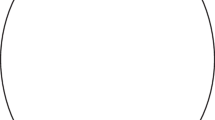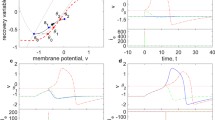Abstract
The types of mathematical model which have been used to represent all-or-none behavior in the nerve membrane may be classified as follows: (1) thediscontinuous threshold phenomenon, in which differential equations with discontinuous functions provide both a discontinuity of response as a function of stimulus intensity at threshold and a finite maximum latency, (2) thesingular-point threshold phenomenon which exists in a phase space having analytic functions in its differential equations and having a singular point with one characteristic root positive and the rest with negative real parts, the latency being unbounded, and (3) thequasi threshold phenomenon, which has a finite maximum latency and continuous functions, but neither a true discontinuity in response nor an exact threshold. Several models of the nerve membrane in the literature are classified accordingly, and the applicability of the different types of threshold phenomena to the membrane is discussed, including an extension to a stochastic model.
Similar content being viewed by others
Literature
Blair, E. and J. Erlanger. 1933. “A Comparison of the Characteristics of Axons through their Individual Electrical Responses”.Am. Jour. Physiol.,106, 524–64.
Bonhoeffer, K. F. 1941. “Über die Aktivierung von Passiven Eisen in Salpetersaüre.”Ztschr. für Elektrochemie,47, 147–50.
— 1948. “Activation of Passive Iron as a Model for the Excitation of Nerve.”Jour. Gen. Physiol.,32, 69–91.
— 1953. “Modelle der Nervenerregung.”Die Naturwissenschaften,40, 301–11.
Cole, K. S. 1949. “Dynamic Electrical Characteristics of the Squid Axon Membrane.”Arch. Sci. Physiol.,3, 253–58.
— 1954. “Membrane Excitation of the Hodgkin-Huxley Axon.”Fed. Proc.,13, 28.
Cole, K. S., H. A. Antosiewicz, and P. Rabinowitz. 1955. “Automatic Computation of Nerve Excitation.”Jour. Indust. Appl. Math. In press.
Fatt, P. and B. Katz. 1952. “Spontaneous Subthreshold Activity at Motor Nerve Endings.”Jour. Physiol.,117, 109–28.
Hill, A. V. 1936. “Excitation and Accommodation in Nerve.”Proc. Roy. Soc. Lond., B.,119, 305–55.
Hodgkin, A. L. 1952. “Measurement of Current-Voltage Relations in the Membrane of the Giant Axon ofLoligo.”Jour. Physiol.,116, 424–48.
— and A. F. Huxley. 1952. “A Quantitative Description of Membrane Current and Its Application to Conduction and Excitation in Nerve.”Jour. Physiol.,117, 500–544.
——, and B. Katz. 1949. “Ionic Currents Underlying Activity in the Giant Axon of the Squid.”Arch. Sci. Physiol.,3, 129–50.
Johnson, F. H., H. Eyring, and M. J. Polissar. 1954.The Kinetic Basis of Molecular Biology. New York: J. Wiley and Sons, Inc.
Johnson, J. B. 1928. “Thermal Agitation of Electricity in Conductors.”Phys. Rev.,32, 97–109.
Karreman, C. 1951. “Contributions to the Mathematical Biology of Excitation with Particular Emphasis on Changes in Membrane Permeability and on Threshold Phenomena.”Bull. Math. Biophysics,13, 189–243.
— and H. D. Landahl. 1952. “On the Mathematical Biology of Excitation Phenomena.”Cold Spring Harbor Symp. Quant. Biol.,17, 293–97.
— and —. 1953. “On Spontaneous Discharges Obtained from a Physicochemical Model of Excitation”.Bull. Math. Biophysics,15, 83–91.
Lefschetz, S. 1948.Lectures on Differential Equations. Princeton: Princeton University Press.
Lotka, A. J. 1925.Elements of Physical Biology. Baltimore: Williams and Wilkins Co.
Marmont, G. 1949. “Studies on the Axon Membrane. I. A New Method.”Jour. Cell. Comp. Physiol.,34, 351–82.
Minorsky, N. 1947.Introduction to Non-linear Mechanics. Ann Arbor: J. W. Edwards.
Nyquist, H. 1928. “Thermal Agitation of Electrical Charge in Conductors.”Phys. Rev.,32, 110–13.
Offner, F., A. Weinberg, and G. Young. 1940. “Nerve Conduction Theory: Some Mathematical Consequences of Bernstein's Model.”Bull. Math. Biophysics,2, 89–103.
Pecher, C. 1939. “La Fluctuation d'Excitabilité de la Fibre Nerveuse.”Arch. Internat. Physiol.,49, 129–52.
Petrowsky, I. 1934. “Über das Verhalten der Integralkurven eines Systems gewöhnlicher Differentialgleichungen in der Nähe eines singulären Punktes.”Recueil Math.,41, 107–56.
Rashevsky, N. 1933. “Outline of a Physico-mathematical Theory of Excitation and Inhibition.”Protoplasma,20, 42–56.
— 1948.Mathematical Biophysics. Rev. Ed., Chicago: University of Chicago Press.
— 1954. “Topology and Life: In Search of General Mathematical Principles in Biology and Sociology”.Bull. Math. Biophysics,16, 317–48.
Rushton, W. A. H. 1938. “Initiation of the Propagated Disturbance”.Proc. Roy. Soc. Lond., B.,124, 210–43.
Author information
Authors and Affiliations
Rights and permissions
About this article
Cite this article
FitzHugh, R. Mathematical models of threshold phenomena in the nerve membrane. Bulletin of Mathematical Biophysics 17, 257–278 (1955). https://doi.org/10.1007/BF02477753
Received:
Issue Date:
DOI: https://doi.org/10.1007/BF02477753




